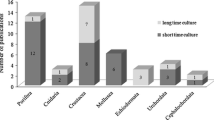Abstract
Establishing tissue cultures derived from deep-sea multicellular organisms has been extremely difficult because of the serious damage they sustain upon decompression and exposure to the high temperature of surface seawater. We developed a novel pressure-stat aquarium system for the study of living deep-sea multicellular organisms under pressure. Using this system, we have succeeded in maintaining a variety of deep-sea multicellular organisms under pressure and atmospheric conditions after gradual, slow decompression. Furthermore, we successfully cultivated and freeze-stocked pectoral fin cells of the deep-sea eel Simenchelys parasiticus collected at a depth of 1,162 m under atmospheric pressure conditions. This review describes novel capture and maintenance devices for deep-sea organisms and cell culture studies of the organisms under atmospheric and pressure conditions.











Similar content being viewed by others
References
Cecil JT (1969) Mitosis in cell cultures from cardiac tissue of the surf clam Spisula solidissima. J Invest Pathol 14:407–410
Fujiwara Y, Tsukahara J, Hashimoto J et al (1998) In situ spawning of a deep-sea vesicomyid clam: evidence for an environmental cue. Deep-Sea Res I 45:1881–1889
Gibbs AG (1997) Biochemistry at depth. In: Randall DJ, Farrell AP (eds) Deep-sea fishes. Academic Press, San Diego, pp 239–277
Giese AC, Kanatani H (1987) Maturation and spawning. In: Giese AC, Pearse JS, Pearse VB (eds) General aspects: seeking unity in diversity. Reproduction of marine invertebrates, vol. 9. Blackwell Scientific Publications and Boxwood Press, Palo Alto and Pacific Grove, California, pp 251–329
Hashimoto J, Fujikura K, Aoki T et al (1992) Development of a suction sampler (slurp gun) for deep sea organisms. Proc JAMSTEC Symp Deep Sea Res 8:367–372
Horikoshi K, Tsujii K (1999) Extremophiles in deep-sea environments. Springer, Tokyo
Koyama S (2003) Acclimatization for deep-sea multicellular organisms under atmospheric pressure. Biosci Ind 61:36–37
Koyama S, Aizawa M (2000) Tissue culture of the deep-sea bivalve Calyptogena soyoae. Extremophiles 4:385–389
Koyama S, Miwa T, Sato T et al (2001) Optical chamber system designed for microscopic observation of living cells under extremely high hydrostatic pressure. Extremophiles 5:409–415
Koyama S, Miwa T, Horii M et al (2002) Pressure-stat aquarium system designed for capturing and maintaining deep-sea organisms. Deep-Sea Res I 49:2095–2102
Koyama S, Horii M, Miwa T et al (2003a) Tissue culture of the deep-sea eel Simenchelys parasiticus collected at 1,162 m. Extremophiles 7:245–248
Koyama S, Horii M, Miwa T et al (2003b) Erratum. Extremophiles 7:340
Koyama S, Nagahama T, Ootsu N et al (2005a) Survival of deep-sea shrimp (Alvinocaris sp.) during decompression and larval hatching at atmospheric pressure. Mar Biotechnol 7:272–278
Koyama S, Kobayashi H, Inoue A et al (2005b) Effects of the piezo-tolerance of cultured deep-sea eel cells on survival rates, cell proliferation, and cytoskeletal structures. Extremophiles 9:449–460
Li MF, Stewart JE (1966) In vitro cultivation of cells of the oyster, Crassostrea virginica. J Fish Res BD Canada 23:595–599
Macdonald AG, Gilchrist I (1978) Further studies on the pressure tolerance of deep-sea crustacea, with observations using a new high-pressure trap. Mar Biol 45:9–21
Momma H, Mitsuzawa K, Kaiho Y et al (1995) Long-term deep sea floor observation off Hatsushima Island in Sagami Bay—one year in the Calyptogena soyoae clam colony. JAMSTEC J Deep Sea Res 11:249–268
Nakabo T (2000) Fishes of Japan with pictorial keys to the species, 2nd edn. Tokai University Press, Tokyo
Odintsova NA, Khomenko AV (1991) Primary cell culture from embryos of the Japanese scallop Mizuchopecten yessoensis (bivalvia). Cytotechnology 6:49–54
Siebenaller JF, Somero GN (1979) Pressure-adaptive differences in the binding and catalytic properties of muscle-type (M4) lactate dehydrogenases of shallow- and deep-living marine fishes. J Comp Physiol B 129:295–300
Smith KL Jr, Baldwin RJ (1997) Laboratory and in situ methods for studying deep-sea fishes. In: Randall DJ, Farrell AP (eds) Deep-sea fishes. Academic Press, San Diego, pp 351–378
Takeuchi Y, Inoue K, Miki D et al (1999) Cultured mussel foot cells expressing abyssal protein genes. J Exp Zool 283:131–136
Van Dover CL (1994) In situ spawning of hydrothermal vent tubeworms (Riftia pachyptila). Biol Bull 186:134–135
Van Dover CL (2000) The ecology of deep-sea hydrothermal vents. Princeton University Press, Princeton, New Jersey
Wilson RR Jr, Smith KL Jr (1985) Live capture, maintenance and partial decompression of a deep-sea grenadier fish (Coryphaenoides acrolepis) in a hyperbaric trap-aquarium. Deep-Sea Res 32:1571–1582
Yayanos AA (1978) Recovery and maintenance of live amphipods at a pressure of 580 bars from an ocean depth of 5,700 m. Science 200:1056–1059
Acknowledgments
The author is grateful to Dr. Masuo Aizawa (Tokyo Institute of Technology) and Dr. Koki Horikoshi (JAMSTEC) for helpful support and advice. The author also thanks Dr. Tetsuya Miwa for the gift of a deep-sea fish photograph.
Author information
Authors and Affiliations
Corresponding author
Rights and permissions
About this article
Cite this article
Koyama, S. Cell biology of deep-sea multicellular organisms. Cytotechnology 55, 125–133 (2007). https://doi.org/10.1007/s10616-007-9110-3
Received:
Accepted:
Published:
Issue Date:
DOI: https://doi.org/10.1007/s10616-007-9110-3



